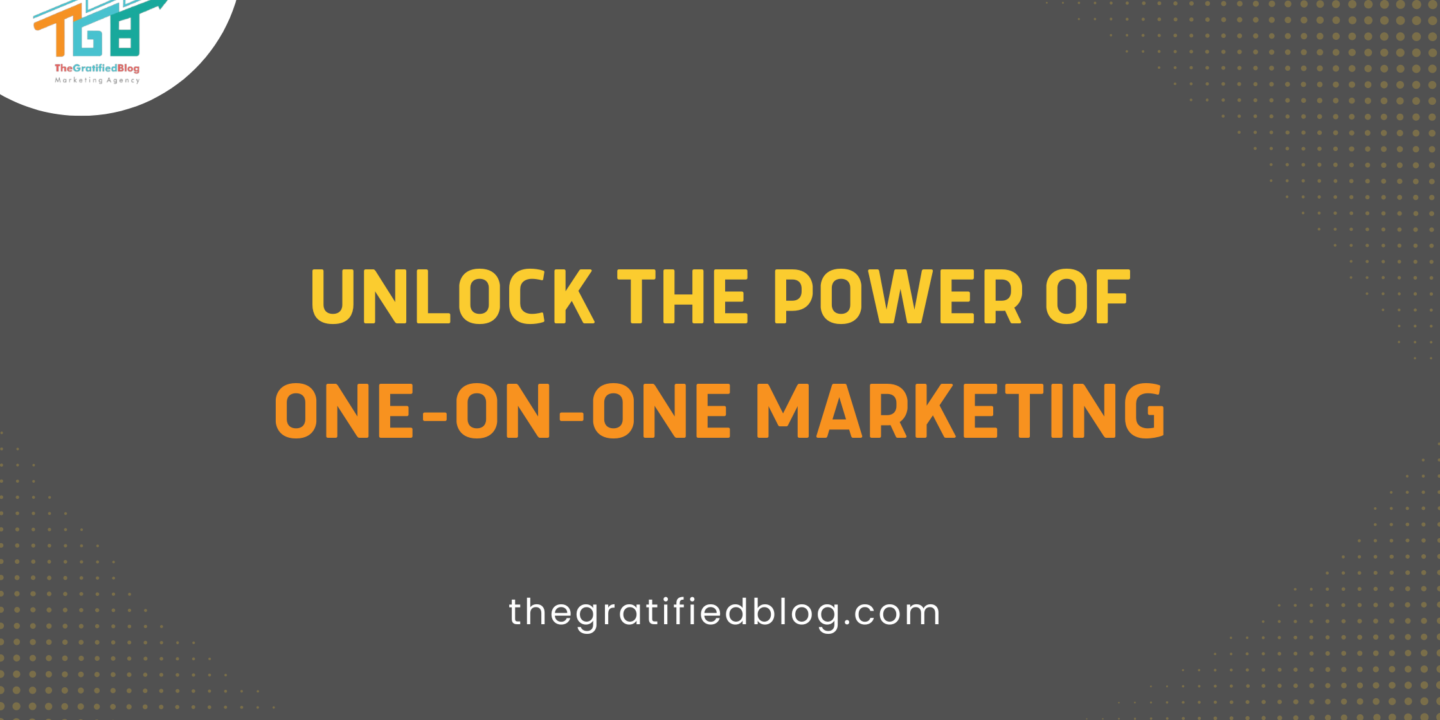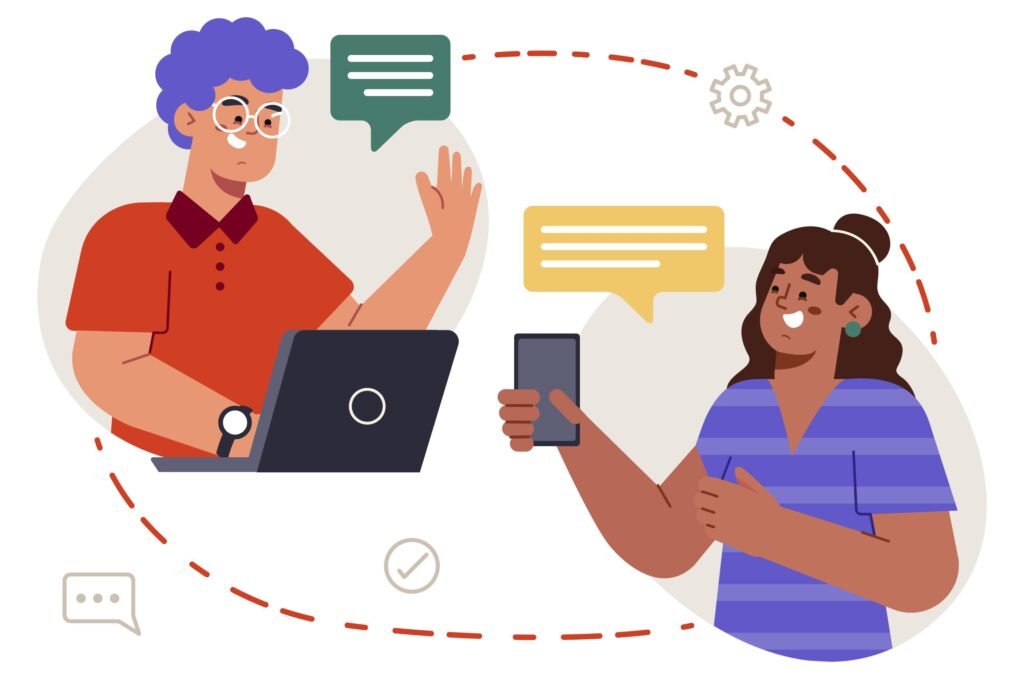
In the ever-evolving marketing landscape, where consumer preferences shift rapidly, and competition intensifies, businesses increasingly turn to personalised approaches to engage with their audience effectively. One such strategy gaining significant traction is “one-to-one marketing.” This tailored approach goes beyond traditional mass marketing techniques, aiming to create individualised experiences for each customer.
In this blog post, we delve into the concept of one-to-one marketing, its definition, significance, and practical strategies for businesses to harness its potential. Additionally, we’ll uncover specific examples of one-to-one marketing in action, demonstrating its real-world application and impact.
Join us to unlock the potential of one-to-one marketing and discover how it can revolutionise your marketing efforts, driving greater customer satisfaction, loyalty, and business success.
So, let’s get started:
Understanding One-On-One Marketing
One-on-one marketing, or personalised or individualised marketing, is a targeted approach that tailors marketing efforts to meet individual customers’ specific needs and preferences.
Unlike traditional mass marketing, which employs generic messages and campaigns aimed at broad audiences, one-on-one marketing leverages data and technology to create personalised experiences for each customer.
Importance Of Personalization In Marketing
Enhanced Engagement
Personalisation in marketing captures attention and encourages interaction by tailoring messages and offers to individual preferences, increasing engagement with the brand.
Improved Conversion
By delivering relevant content and recommendations, personalisation fosters a sense of customer connection and trust, leading to higher conversion rates and, ultimately, more sales.
Now that you understand what one-on-one marketing entails and why personalisation holds significance, let’s delve into the advantages of one-on-one marketing.
Benefits Of One-On-One Marketing
Enhanced Customer Experience
- Tailored Product Recommendations: Instead of bombarding customers with generic product suggestions, one-on-one marketing analyses individual preferences and purchase history to offer personalised recommendations that align with their interests and needs. This results in a shopping experience that is both pertinent and enjoyable, increasing the likelihood of purchase.
- Personalised Communication Channels: One-on-one marketing Enables businesses to engage with customers via their chosen communication channels, regardless of email, social media, SMS, or personalised website experiences. Companies can enhance communication effectiveness and strengthen relationships by engaging customers on their frequent platforms.
- Improved Customer Satisfaction and Loyalty: By delivering tailored experiences and relevant offers, one-on-one marketing demonstrates to customers that their preferences are valued and understood. This personalised approach fosters a sense of customer appreciation and loyalty, leading to higher satisfaction levels and an increased likelihood of repeat purchases.
Increased Conversion Rates
- Targeted Messaging and Offers: One-on-one marketing enables businesses to craft targeted messages and offers based on individual customer data, such as browsing behaviour, purchase history, and demographic information. By providing content and promotions that align with each customer’s interests and needs, businesses could enhance the probability of conversion and stimulate increased sales.
- Higher Engagement and Click-Through Rates: Personalized marketing messages are more likely to capture recipients’ attention and encourage interaction. By customising content to align with the preferences and behaviours of each customer, one-on-one marketing campaigns can achieve higher engagement rates and increase click-through rates, ultimately leading to more conversions.
Improved Marketing ROI
- Reduced Wastage of Resources: By targeting marketing efforts towards specific audience segments, one-on-one marketing minimises the wastage of resources on irrelevant or uninterested prospects. This optimisation ensures that marketing resources are allocated efficiently, maximising the return on investment.
- Better Allocation of Budget: One-on-one marketing relies on data-driven insights to allocate marketing budgets effectively. By identifying high-value segments and channels that yield the best results, businesses can optimise their spending to achieve maximum impact and ROI.
- Long-Term Customer Lifetime Value (CLV): By focusing on building long-term relationships with customers through personalised experiences and tailored communication, one-on-one marketing enhances customer loyalty and retention. This increases lifetime value as loyal customers make repeat purchases and contribute more revenue over time.
Having gained insight into one-on-one marketing and its advantages, let’s now delve into the strategies for its implementation.
Strategies For Implementing One-On-One Marketing
Data Collection And Analysis

Utilising Systems for Managing Customer Relationships (CRM):
- Systems for Managing Customer Relationships (CRM) are potent tools for collecting, organising, and analysing customer data. These systems centralise customer information, including contact details, purchase history, interactions, and preferences, providing a comprehensive view of each customer.
- By utilising CRM systems, businesses can track customer interactions across various touchpoints, such as website visits, email opens, and social media engagements. This data enables companies to understand customer behaviours, preferences, and needs, laying the foundation for personalised marketing strategies.
- CRM systems also facilitate segmentation and targeting efforts by allowing businesses to categorise customers based on various criteria, such as demographics, purchase frequency, and engagement levels. This segmentation facilitates more precise and pertinent marketing campaigns, enhancing the effectiveness of one-on-one marketing initiatives.
Leveraging Big Data and Analytics:
- Big data and analytics play a crucial role in one-on-one marketing by providing valuable insights into customer behaviour and trends. Businesses can uncover meaningful patterns and correlations by Analyzing extensive amounts of data from various origins, including online interactions, transactional data, and social media activity.
- Data analytics techniques like predictive analytics and machine learning enable businesses to predict future customer behaviour and preferences. By identifying patterns in historical data, companies can anticipate customer needs and deliver personalised experiences in real-time.
- Additionally, big data analytics can uncover hidden opportunities for personalisation, such as identifying cross-selling or upselling opportunities based on past purchase behaviour. By leveraging these insights, businesses can tailor their marketing messages and offers to each customer, driving higher engagement and conversion rates.
Segmentation And Targeting
Demographic Segmentation:
- Demographic segmentation involves categorising customers based on demographic attributes such as age, gender, income, education, and occupation. This segmentation approach helps businesses understand the characteristics and preferences among diverse customer segments, enabling them to tailor their marketing efforts accordingly.
- Businesses can devise marketing campaigns targeted to resonate with particular audience segments by segmenting customers demographically. For example, a clothing retailer may create different ad campaigns for different age groups or genders, featuring products and messaging that appeal to each segment’s unique preferences.
- Demographic segmentation also enables businesses to allocate marketing resources more effectively by prioritising segments with higher potential value or responsiveness. By focusing on the most relevant segments, companies can maximise the impact of their one-on-one marketing initiatives and achieve better results.
Behavioural Segmentation:
- Behavioural segmentation involves categorising customers based on their past behaviours, interactions, and engagement with the brand. This segmentation approach focuses on understanding how customers interact with products, websites, emails, and other marketing channels.
- Businesses can identify patterns and preferences that drive purchasing decisions by segmenting customers behaviorally. As an illustration, companies can categorise customers according to browsing history, purchase frequency, cart abandonment behaviour, or product preferences.
- Behavioural segmentation enables businesses to deliver personalised recommendations, offers, and messaging based on each customer’s past interactions and behaviours. Businesses can increase engagement, satisfaction, and conversions by tailoring marketing efforts to match individual preferences and needs.
Psychographic Segmentation:
- Psychographic segmentation involves categorising customers based on their attitudes, values, lifestyles, and personality traits. This segmentation approach goes beyond demographic and behavioural characteristics to understand the underlying motivations and preferences that drive consumer behaviour.
- By segmenting customers psychographically, businesses can create more nuanced and targeted marketing campaigns that resonate with customers on a deeper level. For example, a travel company may segment customers based on their adventurousness, luxury preferences, or desire for cultural experiences.
- Psychographic segmentation enables businesses to craft messaging and offers that align with each customer’s unique interests, values, and aspirations. By appealing to customers’ emotions and motivations, companies can foster stronger connections and loyalty, driving long-term relationships and repeat purchases.
Personalised Communication

Email Marketing:
- Email marketing is a potent instrument for distributing personalised messages and offers directly to customers’ inboxes. Businesses can tailor their email campaigns to resonate with each recipient by segmenting email lists according to customer preferences, behaviours, and demographics.
- Personalised email marketing can include customised subject lines, content recommendations, product suggestions, and promotional offers based on individual customer data. Businesses can enhance open rates, click-through rates, and conversions by sending relevant and timely emails.
- Email marketing automation tools and personalization features enable businesses to efficiently scale their one-on-one marketing efforts. By establishing automated email workflows activated by particular customer actions or events, companies can deliver personalised messages at the opportune moment, resulting in increased engagement and ROI.
Social Media Marketing:
- Social media marketing empowers businesses to engage directly with their customers personally and deliver targeted content and promotions. Companies can identify relevant segments and tailor their social media strategy by analysing data and audience insights.
- Personalised social media marketing can create custom audiences based on demographic, behavioural, or interest-based criteria. Businesses can then deliver personalised ads, content, and offers to these segmented audiences, increasing relevance and engagement.
- Social media platforms offer various features and tools for personalisation, such as ad targeting options, dynamic ad creative, and personalised messaging. By leveraging these features, businesses can enhance their one-on-one marketing efforts on social media and drive meaningful customer interactions.
Website Customization:
- Website customisation involves tailoring the online experience for each visitor based on their preferences, behaviours, and past interactions. By leveraging website personalisation tools and technologies, businesses can deliver a personalised experience that meets each visitor’s unique needs.
- Personalised website experiences can include dynamic content, product recommendations, targeted offers, and personalised messaging based on customer data. Businesses can increase engagement, time on site, and conversion rates by presenting relevant content and offers to visitors.
- Website personalisation tools use data-driven insights and machine learning algorithms to deliver real-time personalised experiences. By analysing visitor behaviour and preferences, these tools can dynamically adjust website content and layout to match each visitor’s interests and intent, enhancing the overall user experience.
Feedback And Adaptation

Customer Surveys and Feedback Mechanisms:
- Customer surveys and feedback mechanisms provide valuable insights into customer preferences, satisfaction levels, and pain points. Businesses can better comprehend customer needs and expectations by collecting feedback through surveys, reviews, and customer support interactions.
- One-on-one marketing strategies can incorporate customer feedback to refine personalisation efforts and improve the customer experience. By attentively considering and responding to customer feedback, businesses can demonstrate their unwavering commitment to customer satisfaction and cultivate stronger relationships.
- Customer feedback can also inform product development, marketing messaging, and overall business strategy. By incorporating customer insights into decision-making processes, businesses can adjust and develop to fulfil evolving customer requirements and market dynamics.
A/B Testing and Continuous Optimization:
- A/B testing entails the comparison of two or more variations of a marketing campaign, webpage, or content asset to discern which yields superior results in engagement or conversion metrics. By testing different elements such as headlines, images, calls-to-action, or offers, businesses can identify the most effective strategies for engaging customers.
- Continuous optimisation involves iterating and refining marketing campaigns based on performance data and insights gathered over time. Businesses can optimise their one-on-one marketing efforts by analysing campaign results, identifying areas for improvement, and implementing changes.
Examples Of One-On-One Marketing
Grammarly— Personalized Emails
The premium and freemium versions of Grammarly offer distinct email notifications generated from user data. These weekly digests, dispatched every Monday, showcase enhancements in productivity, vocabulary, accuracy, and other areas for users.
The freemium model of the Grammarly app restricts access to many grammar corrections users could implement, and the weekly digest serves as a reminder to users of the potential benefits of upgrading to a premium account.
Spotify — Personalized Music Playlist
If you’re a Spotify user, chances are you’ve enjoyed their “Discover Weekly” playlist, a personalised compilation tailored to each user’s preferences. This playlist draws recommendations from the genres, artists, and playlists you engage with on the platform.
It exemplifies Spotify’s one-to-one approach to playlist curation, providing a unique and tailored marketing experience for each customer. By offering this weekly algorithmically-generated playlist, Spotify aims to foster user loyalty and encourage continued music streaming. If you’re curious about the intricacies of Spotify’s Discover algorithm, delve deeper into its magic.
Conclusion
Having explored every facet of one-on-one marketing, it’s clear that this personalised approach offers significant potential for businesses to establish deeper bonds with their
audience. Nonetheless, as you set out to integrate one-on-one marketing strategies, it’s crucial to remain adaptable, rely on data insights, and prioritise customer-centricity. Doing so can optimise your efforts and successfully attain your marketing objectives.
If you still have any questions related to the blog, please leave them in the comments section below. We will be happy to answer you.
Thanks for reading 🙂








No Comments